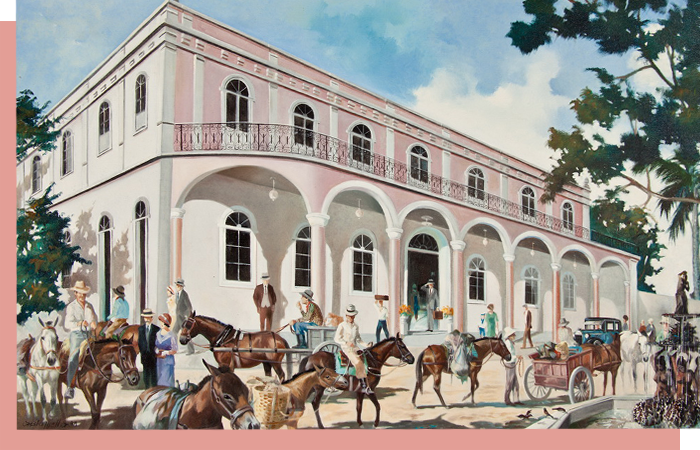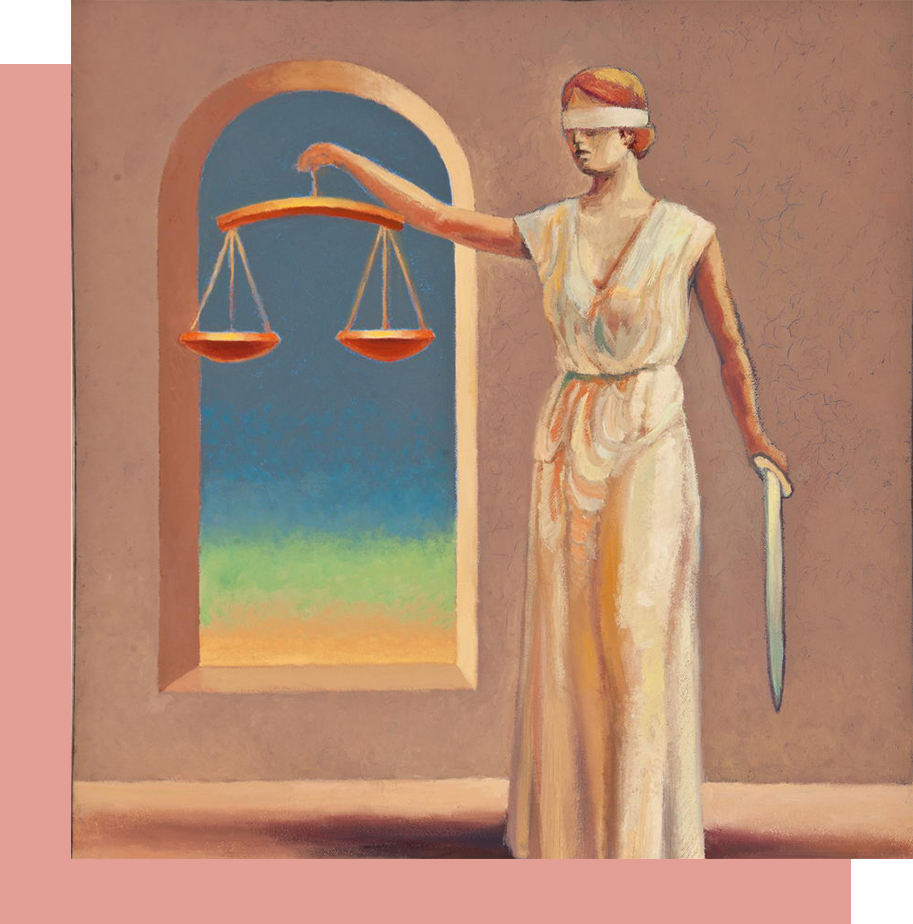

Standing out of the landscape for its palatial-style architecture, the pink townhouse on the corner of Rua Lourenço Pinto and Rua Sete de Setembro was built around 1850, a time when the architecture of Curitiba was undergoing major changes, as it was losing the Portuguese-Brazilian air that until then characterized it.
This transformation was greatly influenced by German and Italian master builders, especially in local constructions, in the mid-nineteenth century. Thus, the architecture of this townhouse reflects the traits of these professionals, who were probably present in the construction work itself.
The neoclassical lines and the portico topped by a terrace with its hipped roof, hidden by a platband and adorned by vases, ensure the influence of the Italian masters.
The construction of the building was contemporary to the transformations undergone by the then huge front square, named Eufrásio Correia, in 1888. With undergrowth, the square began to change at the beginning of this decade, when the construction of the railway station and the urban expansion project for the region began.
The works on the station gave impetus and brought an air of modernity to a space that was only eight hundred meters away from the central core of the city, but which was until then uninhabited.
Nearby streets, such as Silva Jardim, Marechal Floriano Peixoto and Desembargador Westphalen, went through improvements; transversal streets were rectified. The street named Rua da Liberdade, today named Barão do Rio Branco, was opened, transforming the station building into the focal point of a perspective that linked the railroad terminal to the traditional center of Curitiba.

Around the station and on Rua da Liberdade, hotels and commercial houses were installed; townhouses that combine commerce with residence were built. Public bodies, such as the House of Representatives (now the Council building) and the Government Palace – the former headquarters of the Museum of Image and Sound (MIS – Museu da Imagem e do Som) found a suitable address on Rua da Liberdade. This was so because the road, in addition to being an obligatory way for most authorities who arrived here, was also the stage for civic parades.
In this context, the pink townhouse with some white details was built, owned by the family of Colonel Amazonas de Araújo Marcondes until the beginning of the 20th century. It is known that, until then, the building had little residential use, because by the time it was sold to the Italian naturalized Brazilian Emilio Romani, it had already housed the offices of the firm that managed the animal-drawn tram service in Curitiba, the administration of the French railroad that built the extension of the railroad to Ponta Grossa and the 39th Infantry Regiment in the capital, located there around 1894. With the departure of the Infantry, the building was occupied by the 2nd Engineering Regiment, which was coming from Porto Alegre.

Emilio Romani acquired the property for investment purposes, the reason why the townhouse has continued to have a number of commercial and institutional uses over the years. It has hosted warehouses, sports clubs, charitable societies and public bodies.
In the 1920s, a local soccer team called Britânia Futebol Clube was there, training in the area where the Technology University of Paraná, formerly CEFET, is located. The club was headquartered on Rua 15 de Novembro, but soon moved to the area opposite Praça Eufrásio Correia, the address closest to the training venues.
These headquarters went down in history as Britânia’s most charming one: “(…) but the club’s charm was really the head office, in the beautiful building, now owned by the firm Emilio Romani, at Praça Eufrásio Correia, in front of the old train station. There were games, dinners, and balls every Sunday. Britânia’s victories and titles were celebrated with big parties, bringing together young ladies from high society, fans and, above all, the team players”.
Another team that would have been located there was a soccer team named Clube Atlético Ferroviário. The vocation for sporting activities in the place remained for a long time.
In 1932, a physical training center for young people was inaugurated, as reported by newspaper Gazeta do Povo: “The Physical Preparation Center is inaugurated today in our capital, thanks to the efforts of Lotario Krueger, the renowned fellow athlete.
The aforementioned center is located in the large building at Praça Eufrásio Correia, the former headquarters of Britânia Futebol Clube, and a large number of young people are already registered to take part in the classes that will start today”.
In the 1940s, the place showed signs of the passing of time. Threatened with demolition by the city hall due to its precarious condition, it was recovered by the Romani family with the support of the local energy company called Companhia de Força e Luz do Paraná, which would later occupy the building.
A few years later, however, the halls that housed sports activities and the daily life of an office once again gave way to parties. In the mid-1950s, the townhouse was taken by Sociedade Operária Beneficente 14 de Janeiro, famous for its balls.
In 1961, the house passed over to Adpar – Administração e Participações, a company belonging to the Romani family, which, from then on, took over the management of the property. However, it was only in the following decade, in 1973, that the company, responsible for the industrialization of sugar, coffee, rice and salt, transferred its offices to the townhouse. The company’s activities remained in place until mid-1984, when the Paraná Social Promotion Foundation (Promopar) was installed there.
Public recognition of the townhouse as a cultural asset came in 1977, when the property became a heritage listed building by the State Historical Heritage, just one year after the historic railway station was also listed. After Promopar left the property, it remained listed but was in a poor state of conservation.
In 1999, with the acquisition by the current owners, it was completely restored, keeping its original characteristics. Today it houses Casillo Advogados Office.
Marcelo Saldanha Sutil
Coordinator of Historical Research / Fundação Cultural de Curitiba



Allegories, beliefs, creeds, faith, legends, mysteries, myths, superstitions and symbols, each concept within its limits, have a long and ancient coexistence with the human being.
Such manifestations, either instinctive or intellectual, develop on a larger scale when understanding and knowledge are lacking, especially when faced with the need to identify them with an abstract idea.
In the case of justice, there is a strong tendency to use an anthropomorphic image as a link between idea and form. This aspect is enhanced when justice is viewed independently, or at least predominant, to other qualities such as wisdom, knowledge, etc.
Among the various cultural representations of justice, Greek mythology is undoubtedly the one that provides the best sources for the identification of its gods and goddesses, and also other deities.
In the case of Themis, it would be linked more to the functions of moral control, order and even ceremonial among the members of Olympus. Among her attributes, the main ones are to make them observe the divine law. It would be divine justice that would also apply to men. It could be compared with the notion of “fas” in Roman law, with a predominantly religious meaning.

In the image that represents Justice, three symbols identify its attributes: the scales, the blindfold and the sword.
The scales indicate balance and equidistance.
The blindfold does not mean, as some people want, that Justice is blind. The blindfold symbolizes that the Court should not make its decisions based on the appearance of the parties, but after hearing the legal and factual arguments.
The sword denotes the strength to ensure the execution of decisions.